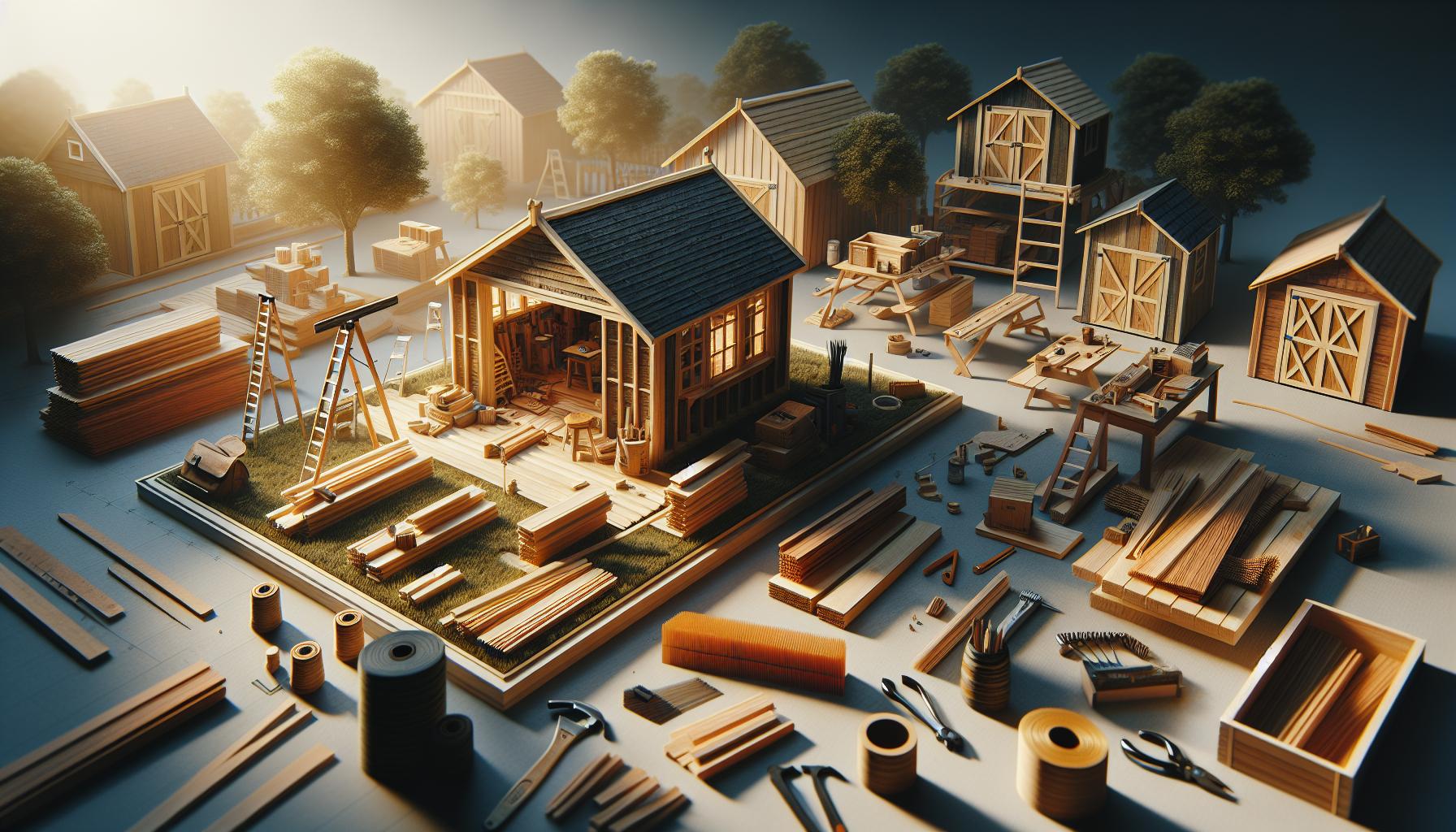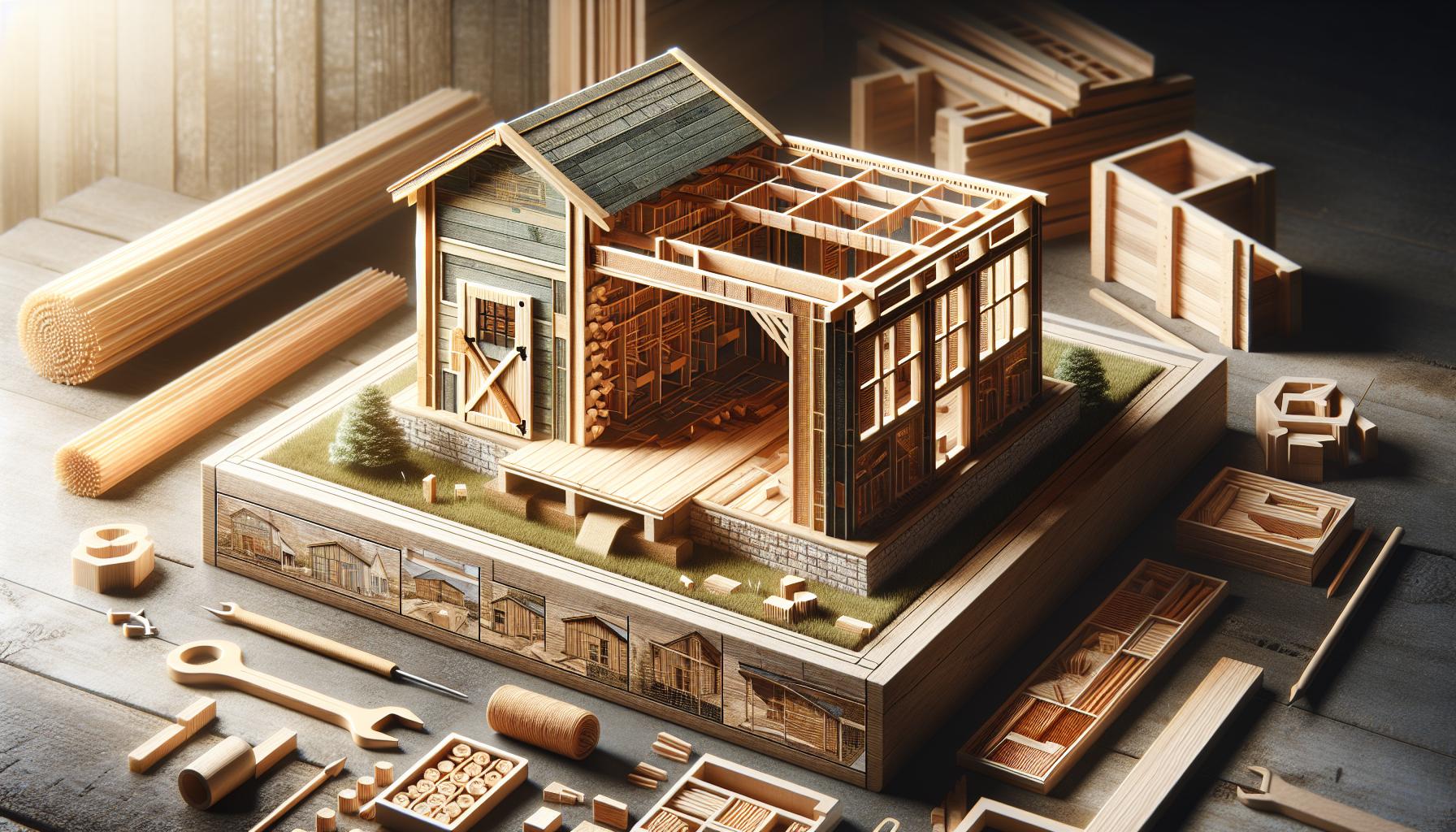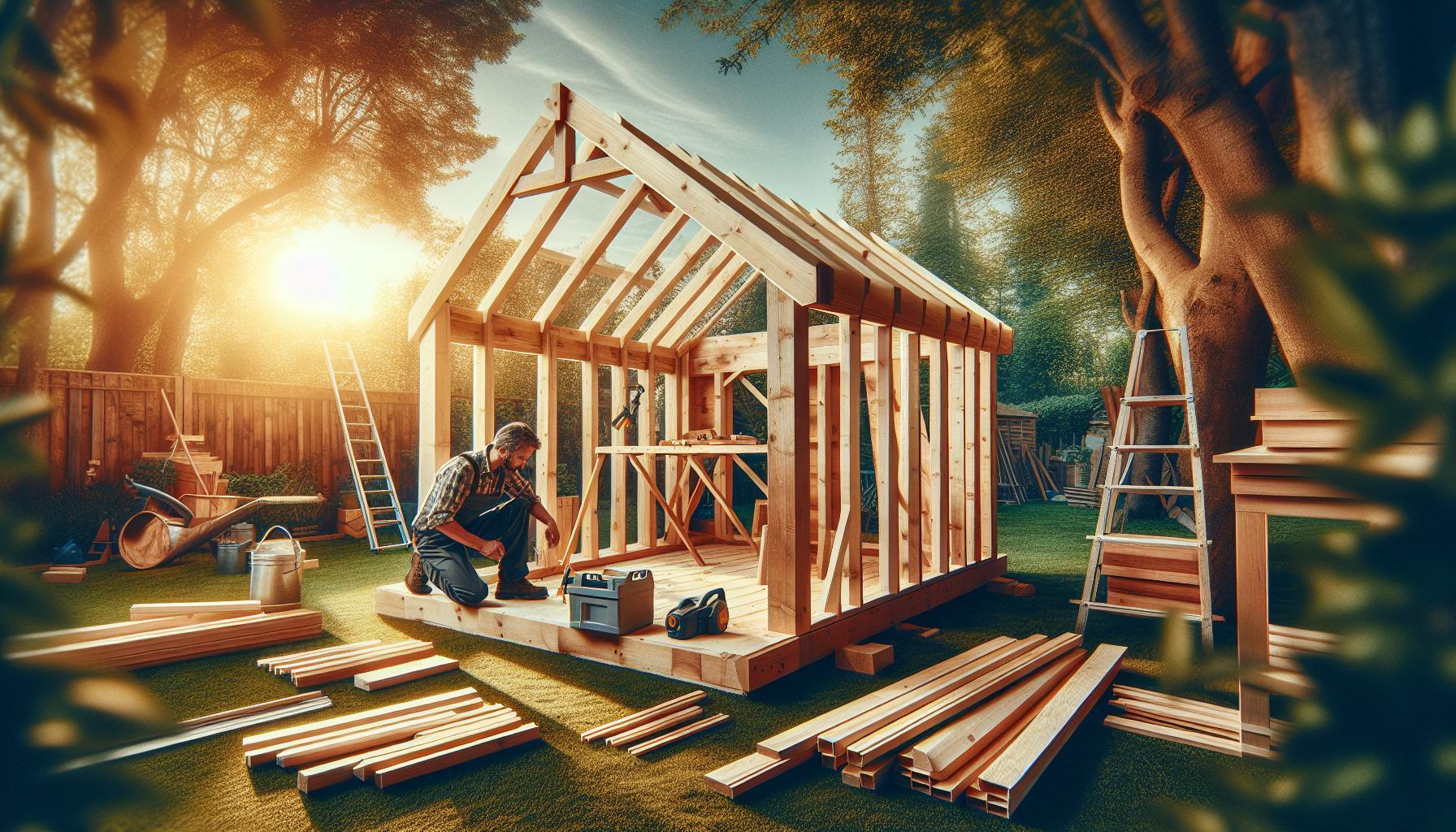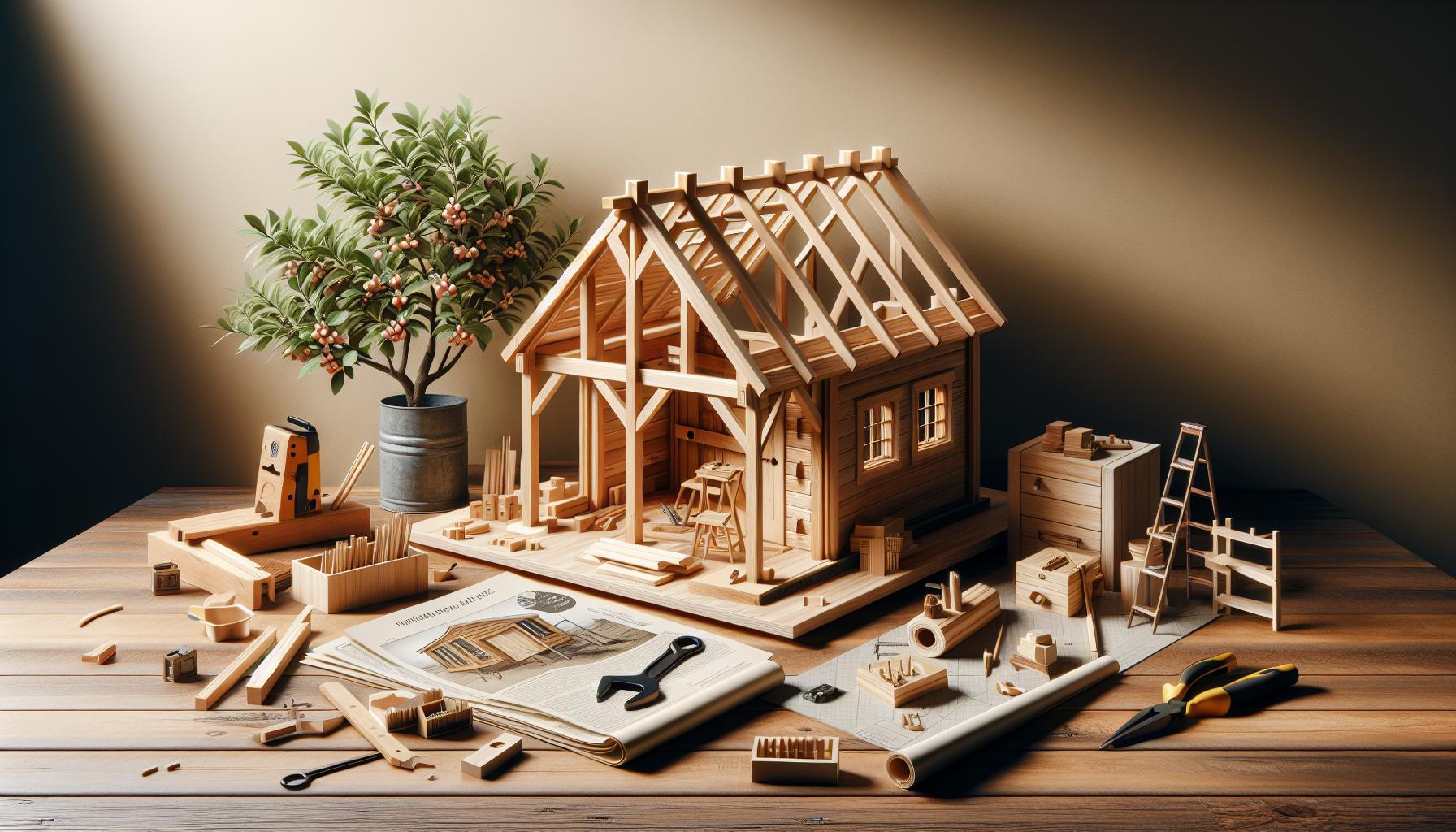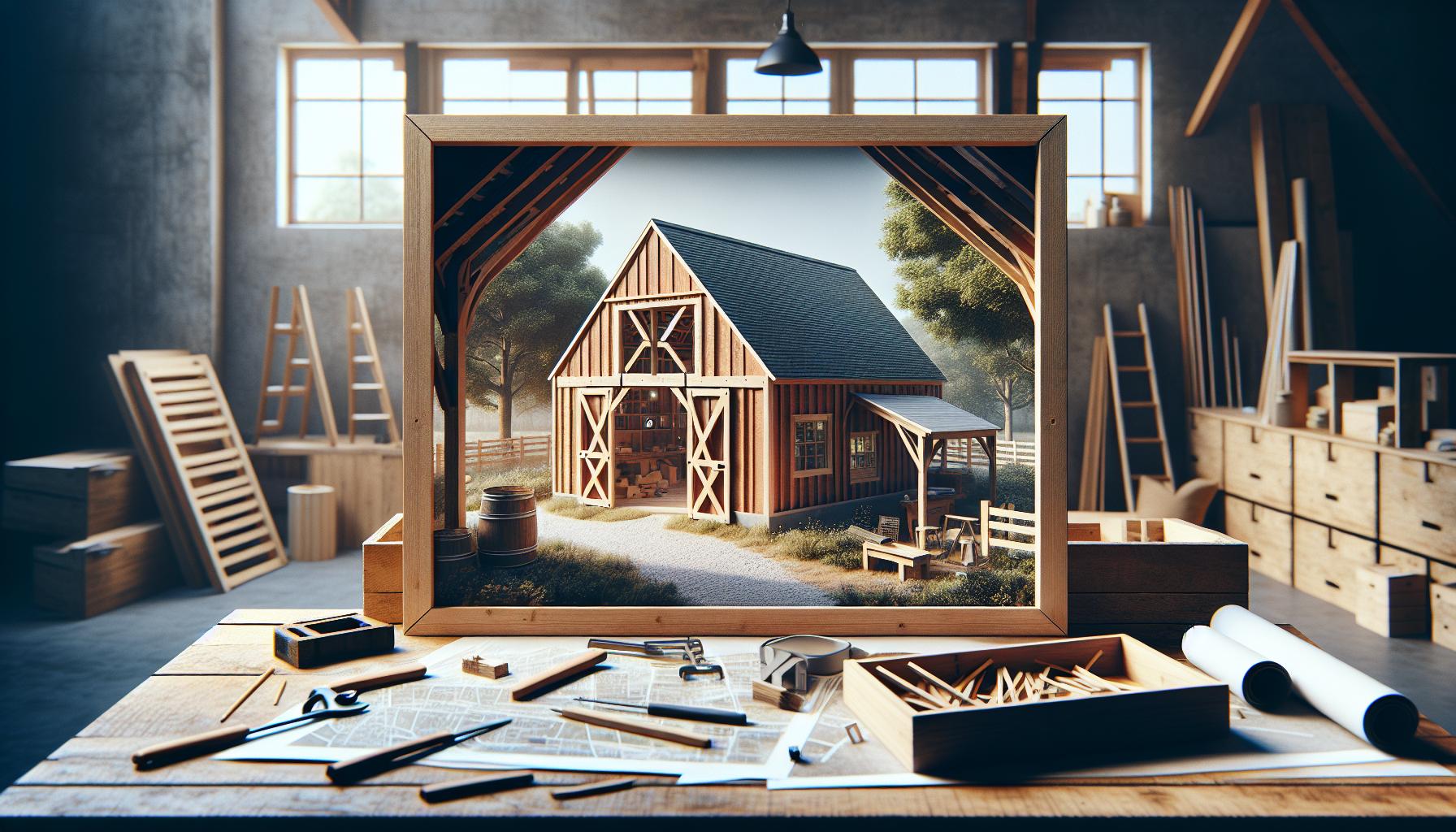Building a sturdy shed begins with a solid foundation—without it, your structure risks settling, warping, or worse. This guide explores various foundation techniques to ensure your shed remains stable and dependable. discover how to choose the right base materials and methods tailored to your soil type and climate for lasting durability.
Understanding the Importance of a Solid Shed Base
When embarking on the journey of constructing a shed, the foundation is arguably the most critical element to consider. A solid base not only provides essential support for your structure but also considerably influences it’s longevity and performance. By ensuring that your shed is properly elevated and protected from moisture, you can prevent common issues such as rot and insect infestation, which can undermine your investment over time.
Why a Stable Foundation Matters
A stable foundation is vital for maintaining the integrity of your shed. Here are key reasons why you should prioritize building a robust base:
- Prevention of Moisture Damage: A well-constructed shed base elevates your shed off the ground, reducing contact with moisture from soil. This is crucial in preserving the wood and materials used in your shed’s construction, ultimately extending its lifespan.
- Structural Stability: A foundation that can support the weight and dimensions of your shed ensures that the structure remains stable in various weather conditions. This stability reduces the risk of warping or breaking under stress.
- Enhanced Drainage: Properly designed bases allow for effective water drainage, preventing flooding or water pooling around your shed, which could lead to further damage and structural concerns.
Choosing the Right Foundation Type
Understanding the different types of shed bases available is integral to ensuring the stability of your structure. Here are some popular options:
| Foundation Type | Description | Best For |
|---|---|---|
| Skids | wooden runners placed under the shed | Lightweight sheds |
| Gravel pads | Compact gravel laid out level for drainage | Medium-duty sheds |
| Concrete Slab | Solid concrete foundation | Heavy-duty or permanent sheds |
The choice of foundation should match your shed’s intended use and weight. For instance,a lightweight garden shed may perform well on a simple gravel pad,while a larger workshop might require a sturdier concrete slab to ensure long-term stability.
In brief, and selecting the appropriate foundation type is essential when considering “How Do You Build a Shed Base? Foundation Techniques for Stability.” This not only protects your investment but also enhances the usability and aesthetics of your outdoor space.
Choosing the Right Foundation Type for Your Shed
When it comes to constructing a solid shed, choosing the right type of foundation can make all the difference. an appropriate foundation not only adds stability but also prolongs the life of your structure by protecting it from weather elements and ground moisture.With various options available, understanding the advantages and disadvantages of each can guide you to the suitable choice for your specific needs.
Types of Shed Foundations
there are several common foundation types to consider when planning your shed base:
- Concrete Slab: This is one of the most durable and stable options. A concrete slab provides a flat and level surface that protects against moisture and pests. Ideal for larger sheds or those used for heavy equipment,it can be more expensive and requires critically important preparation.
- Concrete Blocks: Using concrete blocks can be a cost-effective method for smaller sheds. They elevate the structure off the ground, preventing it from sitting in moisture. However, it’s crucial to ensure the blocks are properly leveled to avoid any issues with stability.
- Gravel Foundation: A gravel foundation allows for excellent drainage,reducing the risk of water pooling around your shed.It involves laying a base of gravel mixed with larger rocks to create a sturdy ground. This option is relatively simple and economical, but it may not provide as much stability as concrete methods.
- Timber Frame: Constructing a timber frame can serve as an effective foundation, especially for smaller, lighter sheds. This method typically involves laying pressure-treated wood beams over gravel or compacted soil. While it may be less durable than concrete, it’s a more affordable option for DIY enthusiasts.
Factors to Consider
When deciding on the foundation type,several factors should influence your choice:
| Foundation Type | Cost | Durability | Installation Complexity | best For |
|---|---|---|---|---|
| Concrete Slab | High | Very High | High | Heavy equipment,permanent sheds |
| Concrete blocks | Medium | High | Medium | Small sheds,moderate weight |
| Gravel Foundation | Low | Medium | Low | Drainage-focused setups |
| Timber Frame | Low | Medium | medium | Lightweight,temporary sheds |
Ultimately,the foundation you choose should align with the intended use of your shed,budgetary constraints,and local climate conditions. A thorough understanding of the pros and cons associated with each foundation type ensures that your investment leads to a well-supported, functional structure for years to come. By evaluating these factors, you can ensure that your shed remains a stable, reliable space that meets all your storage needs while standing resilient against the elements.
Step-by-Step Guide to Preparing the Ground for Stability
Building a stable shed base is crucial for the longevity of your structure, preventing issues like warping, decay, and pest invasions. A well-prepared ground will support your shed, ensuring it remains level and secure throughout the seasons. Follow the steps outlined below to establish the perfect foundation that will enhance stability for years to come.
Assess the site
Begin by choosing an appropriate site for your shed. Look for an area that enjoys good drainage away from standing water,as moisture can undermine the stability of your foundation. Your assessment should include the following:
- Topography: Choose a flat area to minimize leveling work and ensure proper drainage.
- Sunlight: Decide how much sunlight you want on your shed to prevent fading or damage to materials.
- Proximity: Ensure easy access to utilities, the house, or storage areas.
Once you’ve selected the right location, it’s time to prepare the ground thoroughly.
Clear the Area
Before laying any foundation, clear the selected area of all debris, vegetation, and rocks. This step is vital for achieving an even surface. Use a shovel or hoe to dig out roots or larger stones that can interfere with stability.
Level the Ground
Next, leveling the ground will provide a solid and flat foundation. You can use a simple leveling tool or a line level for more extensive areas.Here’s how to level your ground effectively:
- Mark the Area: Outline the shed’s perimeter with stakes and string.
- Check the Levels: Use a long board placed between two stakes to check for high and low spots, adjusting as required.
- Remove Excess Soil: Dig out any high areas and fill in low spots to create an even surface.
Compact the Soil
To ensure longevity and stability, compact the soil after leveling. A soil tamper or plate compactor will help achieve the necessary firmness.This process eliminates air pockets which could later settle and cause movement.Compacting is essential, especially in sandy or loose soil conditions.
consider Foundation Type
there are different techniques to set your shed base depending on your location and shed size. Here’s a brief overview of common methods:
| Foundation Type | Description | Best For |
|---|---|---|
| Concrete Slab | A solid, flat surface provides excellent support. | Permanent sheds in stable climates. |
| Concrete Blocks | Individual blocks create a raised platform. | Sheds needing better ventilation. |
| gravel Pad | A base of gravel for drainage and support. | Areas with moisture issues. |
After evaluating the pros and cons of each method, you can proceed to follow the respective instructions to build your chosen foundation type. By diligently preparing the ground and selecting an appropriate support system, you’ll ensure that your shed stands strong and remains stable against the test of time.
Materials Matter: Selecting the Best Options for Your Shed Base
Selecting the appropriate materials for your shed base is a crucial step that can determine the longevity and stability of your structure. Choosing wisely can help avoid common pitfalls such as sagging, rot, or pest infestations, which can drastically affect the usability of your shed. Different materials offer unique benefits, depending on your local climate, soil conditions, and budget. Here’s a breakdown of the most popular options you might consider.
Key Materials for Your Shed Base
When it comes to constructing a solid shed foundation, you have several material choices. Each option has its pros and cons based on durability, cost, and ease of installation. Here’s a summary of some commonly used materials:
| Material | Pros | Cons |
|---|---|---|
| Concrete Blocks |
|
|
| Wooden Skids |
|
|
| Gravel |
|
|
| Concrete slab |
|
|
Making the Right Choice
when deciding on the best materials for your shed base, consider the specific needs of your shed and its intended use. Such as, a workshop that houses tools and machinery may benefit from a concrete slab for maximum durability. In contrast, a small garden shed can suffice with gravel or wooden skids that are less costly and easier to install.
Additionally, climate plays an essential role in your selection process. Areas with heavy rainfall may require materials that promote drainage, such as gravel or concrete blocks, to prevent water damage. On the other hand, termite-prone regions would benefit from masonry options that are resistant to pests.
Ultimately, investing time and consideration into the materials you use for your shed base will not only enhance its structural integrity but will also provide peace of mind as you go about your projects, knowing that your shed is built on a solid foundation tailored to withstand your specific environment.
Tools and Techniques for a Level Foundation
The foundation of your shed is pivotal for ensuring long-lasting stability and durability. A well-constructed base can prevent issues like sagging, water pooling, and pest infiltration, making it essential to choose the right tools and techniques during the building process. by understanding the different options available, you can ensure that your shed stands strong against the elements and offers a reliable storage solution.
Essential Tools for Preparing the Foundation
When building a shed base, having the right tools by your side can significantly elevate your efficiency and precision. Here are some of the crucial tools you will need:
- Measuring Tape: Essential for accurate measurements to ensure your foundation is the correct size.
- Level: A spirit or laser level will help confirm that your foundation is perfectly flat.
- Shovel: To excavate soil if you’re digging down for a concrete pad or gravel bed.
- Post Hole Digger: Necessary when setting concrete piers or posts for raised foundations.
- Power Drill: Useful for securing wooden frames to ensure stability.
- Wheelbarrow: Ideal for transporting heavy materials such as gravel or concrete.
Foundation Techniques for Stability
Choosing the appropriate foundation technique largely depends on the size of your shed, the ground conditions, and your local climate. Here are some popular methods you might consider:
- Concrete Slab: A solid choice for stability, a concrete slab can resist moisture and provides an excellent base for your shed. Ensure proper drainage by creating a slight slope away from the shed.
- Gravel Base: Ideal for moisture control, a gravel base promotes drainage and prevents rot. Remember to lay a weed barrier to keep plant growth at bay.
- Wooden Beams: Using treated timber beams can offer a level base on uneven ground. Ensure the beams are spaced appropriately to bear the weight of your shed.
- Concrete Piers: If you prefer an elevated foundation,concrete piers can protect your shed from moisture while allowing for ventilation beneath.
Example of a Basic Gravel Foundation
For those choosing a gravel foundation, the process can be both straightforward and effective. Below is an outline of steps to guide you through:
| Step | Description |
|---|---|
| 1 | Choose a Level Area: Find a flat spot on your property, clear of debris. |
| 2 | Excavate the Area: Dig down about 4-6 inches to create a bed for gravel. |
| 3 | Install a Weed barrier: Lay down a landscaping fabric to prevent weed growth. |
| 4 | add Gravel: Pour gravel to the desired depth and level it out with a rake and tamper. |
| 5 | Check Level: Use a level to ensure the surface is even before proceeding to the shed construction. |
By employing these tools and techniques effectively, you will be well on your way to constructing a shed base that stands the test of time, enhancing the overall stability and longevity of your shed while providing an organized space for your belongings.
Strengthening Your Shed Base: tips for Longevity and Durability
Building a shed base is crucial for ensuring the longevity and durability of your structure, yet many overlook its importance in the construction process. A sturdy foundation will not only support the weight of your shed but also prevent moisture ingress, warping, and pests that can lead to costly repairs down the line. By applying the right techniques and using quality materials,you can create a lasting base that withstands the test of time.
Selection of Materials
Choosing the correct materials is foundational to your shed’s longevity. While it may be tempting to opt for cheaper options, investing in quality materials pays off in durability. consider using:
- Pressure-treated lumber: This resists rot and insects,making it ideal for a shed base.
- Concrete blocks or slabs: These provide excellent stability and keep your shed elevated off the ground.
- Gravel: This allows for efficient drainage, preventing water from pooling around your shed base.
Utilizing a combination of these materials can create a robust and long-lasting shed foundation that stands firm against the elements.
Proper Drainage Techniques
Without effective drainage, even the sturdiest shed base can fail prematurely. Water that accumulates can erode the foundation and lead to mold growth inside the shed. Here are some strategies to ensure proper drainage:
- choose the right location: Ensure that your shed is built on a slight slope to promote drainage away from the structure.
- Incorporate a gravel base: A layer of gravel not only aids drainage but also provides a level surface for your shed.
- install gutters and downspouts: If your shed has a roof, directing rainwater away from the base is crucial in preventing water accumulation.
By prioritizing drainage, you enhance the resilience of your shed against water damage.
Regular Maintenance Practices
Even the best-built shed bases require periodic maintenance to ensure their continued performance. Regular checks can prevent small issues from escalating into significant problems. key maintenance practices include:
- Inspect for signs of rot: Periodically check the wooden components for any discoloration or softness, which could indicate moisture damage.
- Clear debris: Remove leaves and other organic matter that may trap moisture against the base.
- Reinforce the foundation: Over time, materials can shift. Regularly check and adjust any blocks or beams that may have become uneven.
With these actionable steps, you can ensure that you are not only building a solid foundation but also maintaining it effectively. In doing so, you create an enduring space that serves your needs for years to come and avoids the costly pitfalls often associated with neglected shed bases.
Addressing Common Challenges During Shed Base Construction
When embarking on the journey of constructing a shed base, it’s not uncommon to encounter a variety of challenges that can impede progress and affect the structural integrity of your project. Understanding these potential pitfalls and learning how to navigate them can make all the difference between a successful installation and a frustrating experience. Several key aspects need attention to ensure your shed base is built to last, providing the foundation necessary for stability.
Preparing the Ground
One of the most critical steps in the process is preparing the ground where your shed base will sit. Uneven terrain can lead to problems such as water pooling, settling, or even shifting over time. here are essential steps to consider:
- Clear the Area: Remove any debris, vegetation, or roots that can interfere with the foundation.
- Check for Level: Use a level to assess the ground and make necessary adjustments. this may involve digging down high spots or adding fill to low spots.
- Mark Your Perimeter: Utilize stakes and string to outline the exact area where the shed will rest, ensuring precision in measurements.
Choosing the Right foundation Material
Selecting the appropriate foundation material can drastically affect your shed’s longevity. Whether you opt for concrete, gravel, or timber, each material comes with its own set of challenges and advantages. Here’s a swift comparison to help you decide:
| Foundation Type | Advantages | Challenges |
|---|---|---|
| Concrete | Durable, strong, low maintenance | Requires careful pouring and curing time |
| Gravel | Good drainage, easy to install | can shift over time, requires periodic maintenance |
| Timber | Aesthetic, easy to build | Vulnerable to rot and pests |
Dealing with Water drainage
Water drainage is another common concern during shed base construction. A poorly drained area can lead to dampness and mold, compromising the integrity of both the base and the shed. Here are some effective strategies:
- Elevate the Base: Consider raising your shed to ensure water runs off and does not accumulate around the foundation.
- Install Drainage Solutions: Incorporate drainage pipes or gravel trenches around the base to direct water away from the shed.
- Use Proper Sloping Techniques: ensure the ground around your shed base slopes away, promoting effective water runoff.
Addressing these common challenges will help you in your quest to build a stable and reliable shed base. Focusing on ground preparation, foundation material selection, and effective drainage strategies not only enhances your construction process but also prolongs the life of your shed, making it a secure addition to your property.
FAQ
How do you build a shed base? Foundation techniques for stability?
To build a stable shed base, you can choose from methods such as concrete slabs, gravel pads, or wooden skids, each providing different levels of stability and drainage. Selecting the right technique depends on your shed’s size, location, and budget.
As an example, if your shed is large or in a wet area, a concrete slab foundation is ideal as it offers long-lasting support and excellent drainage. Alternatively,a gravel pad is suitable for smaller structures and allows for superior drainage but may require more maintenance. Each method has its own set of advantages and considerations, so it’s essential to assess your specific needs.
what is the best foundation type for a shed?
The best foundation type for a shed largely depends on its size and location. Concrete slabs are frequently enough favored for their durability, while gravel pads work well in areas with good drainage.
For example, if you’re in a flood-prone area, consider elevating your shed on piers or using treated wooden skids. It’s important to evaluate the soil type and drainage conditions before deciding. Cleansing your site for levelness will also contribute to a more stable foundation.
Why does a shed base need to be stable?
A stable shed base is crucial as it provides structural integrity,prevents water damage,and ensures that your shed remains level over time. Instability can lead to uneven floors and door misalignments.
Moreover, a well-built foundation can also protect against shifting caused by soil erosion or freeze-thaw cycles. Be sure to consider local climate conditions when planning your foundation to enhance its longevity and performance.
Can I use treated wood for a shed foundation?
Yes, using treated wood is a common practice for shed foundations, especially for skids or beams, as it resists moisture and pest damage. This can prolong the life of your shed.
When using treated wood, ensure it’s rated for ground contact if it will sit directly on the soil. Proper ventilation around your shed is also critically important to prevent moisture buildup that could degrade the wood over time. Check our guide on shed construction tips for more information.
How deep should a shed base be?
The depth of a shed base depends on the foundation type. For concrete, a depth of 4-6 inches is generally sufficient, while gravel bases should be at least 4-8 inches deep for proper drainage.
It’s also essential to ensure that the foundation is at least below the frost line in colder climates to prevent heaving. Always check local building codes and guidelines, as they can provide specific requirements for depth and foundation types in your area.
What tools do I need to build a shed base?
To build a shed base, essential tools include a shovel, level, tape measure, post hole digger (for piers), and a compacting machine for soil and gravel.
Additionally, depending on your chosen method, you may need a concrete mixer, wood saws, or even a hammer drill for anchors. Having the right tools will ensure a more efficient and successful base construction.
can I build a shed base on uneven ground?
Yes,you can build a shed base on uneven ground,but it requires additional preparation. You may need to level the site or use adjustable footings to ensure stability.
In cases of significant slopes, consider constructing a platform to level the base or using multiple levels of concrete blocks to create a stable foundation. Proper planning is essential for achieving a secure and functional shed base in such conditions.
Key Takeaways
building a stable and durable shed base is a essential step that sets the groundwork for your entire project.By understanding the different foundation techniques—whether you opt for a concrete slab, gravel pad, or timber frame—you pave the way for longevity and functionality in your shed. Remember,preparation is key; taking the time to measure,level,and ensure proper drainage will help you avoid common pitfalls.
Embrace the challenges that arise during the construction process as opportunities for learning and growth. Each step you take enhances your skills and confidence, making you more equipped to handle future DIY endeavors. So gather your tools,follow these guidelines,and dive into the rewarding journey of creating your own shed base.
we encourage you to keep exploring,whether you’re searching for tips on tools,next steps for your shed design,or additional landscaping ideas. Engaging with our resources can definitely help you transform your vision into a stunning reality, one project at a time.Happy building!